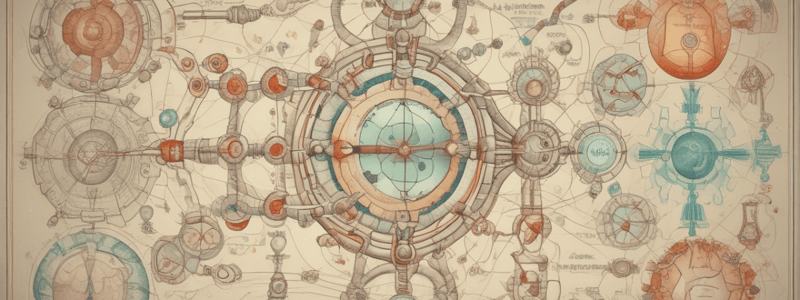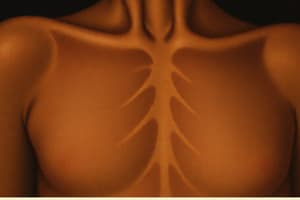Podcast
Questions and Answers
What is a characteristic of receptor-enzymes?
What is a characteristic of receptor-enzymes?
- They act via a G protein and intracellular second messenger.
- They have intrinsic enzymatic activity. (correct)
- They are only found on the cell surface.
- They are only activated by steroids.
What happens to the receptor-hormone complex after activation?
What happens to the receptor-hormone complex after activation?
- It is released back into the bloodstream.
- It stays on the cell surface permanently.
- It is broken down immediately.
- It is endocytosed into the cell and then recycled or broken down. (correct)
What is the function of kinases in peptide signaling?
What is the function of kinases in peptide signaling?
- To phosphorylate and inactivate the receptor (correct)
- To produce a second messenger
- To break down the hormone
- To activate the receptor
Which of the following is NOT a class of hormones?
Which of the following is NOT a class of hormones?
What is a characteristic of peptide hormones?
What is a characteristic of peptide hormones?
What type of receptors do peptide hormones bind to?
What type of receptors do peptide hormones bind to?
What is the effect of altering sensitivity to other chemical messengers on the synthesis of cellular receptors?
What is the effect of altering sensitivity to other chemical messengers on the synthesis of cellular receptors?
What is the solubility of peptide hormones?
What is the solubility of peptide hormones?
What is the primary function of the signal peptide in peptide hormone synthesis?
What is the primary function of the signal peptide in peptide hormone synthesis?
What is the typical half-life of peptide hormones?
What is the typical half-life of peptide hormones?
What is the primary mechanism of peptide hormone secretion?
What is the primary mechanism of peptide hormone secretion?
What is the primary effect of peptide hormone binding to receptors in the target cell's membrane?
What is the primary effect of peptide hormone binding to receptors in the target cell's membrane?
What is the characteristic of glycoprotein hormones?
What is the characteristic of glycoprotein hormones?
What is the typical amino acid sequence of peptide hormones?
What is the typical amino acid sequence of peptide hormones?
What is the mechanism of secretion of steroid hormones in response to pulsatile signals from pituitary hormones?
What is the mechanism of secretion of steroid hormones in response to pulsatile signals from pituitary hormones?
Why do steroid hormones circulate in blood bound to carrier proteins?
Why do steroid hormones circulate in blood bound to carrier proteins?
What is the average half-life of steroid hormones?
What is the average half-life of steroid hormones?
How do steroid hormones enter cells according to the conventional model?
How do steroid hormones enter cells according to the conventional model?
What is the effect of steroid hormones on gene transcription?
What is the effect of steroid hormones on gene transcription?
Where are steroid hormone receptors typically located?
Where are steroid hormone receptors typically located?
What is the function of co-activator proteins in steroid hormone action?
What is the function of co-activator proteins in steroid hormone action?
What is the 'Free Hormone Hypothesis'?
What is the 'Free Hormone Hypothesis'?
Where is the hormone from neurosecretory cells stored?
Where is the hormone from neurosecretory cells stored?
What is the function of Vasopressin (AVP) in the kidney?
What is the function of Vasopressin (AVP) in the kidney?
What is the effect of Oxytocin on the uterus?
What is the effect of Oxytocin on the uterus?
What is released in response to an increase in blood osmolarity?
What is released in response to an increase in blood osmolarity?
What is the effect of Oxytocin on milk letdown?
What is the effect of Oxytocin on milk letdown?
What is the effect of Vasopressin within the brain?
What is the effect of Vasopressin within the brain?
What is a characteristic that catecholamines, such as norepinephrine, epinephrine, and dopamine, have in common?
What is a characteristic that catecholamines, such as norepinephrine, epinephrine, and dopamine, have in common?
Which of the following hormones is lipid-soluble?
Which of the following hormones is lipid-soluble?
What is the function of the hypothalamus in the endocrine system?
What is the function of the hypothalamus in the endocrine system?
What is the posterior pituitary also known as?
What is the posterior pituitary also known as?
Which nuclei of the hypothalamus are involved in the synthesis of hormones stored in the posterior pituitary?
Which nuclei of the hypothalamus are involved in the synthesis of hormones stored in the posterior pituitary?
What is the function of the posterior pituitary?
What is the function of the posterior pituitary?
Which hormone is synthesized in the paraventricular nucleus and stored in the posterior pituitary?
Which hormone is synthesized in the paraventricular nucleus and stored in the posterior pituitary?
What is the connection between the hypothalamus and the pituitary gland?
What is the connection between the hypothalamus and the pituitary gland?
Flashcards are hidden until you start studying
Study Notes
Alteration of Sensitivity to Other Chemical Messengers
- Estradiol (E) increases the synthesis of cellular receptors for progesterone and some neurotransmitters.
Classes of Hormones
- A. Peptides: Water-soluble
- B. Steroids: Lipid-soluble
- C. Amines:
-
- Catecholamines: Water-soluble (NE, EPI, dopamine)
-
- Indoleamines (Serotonin, melatonin)
-
- Thyroid hormones: Lipid-soluble (Triiodothyronine, tetraiodothyronine)
-
Peptide Hormones
- Structure:
- Includes most hormones
- Amino acid sequence can vary among species
- Peptide hormones: ~3-40 amino acids
- Polypeptide/protein hormones: ~50-200 amino acids
- Glycoproteins: protein + carbohydrate
- Synthesis & Storage:
- Water-soluble
- Synthesized as preprohormone
- Signal peptide is cleaved off N-terminal → prohormone
- Enzymatic processing of prohormone → ≥1 hormone
- Hormone (or prohormone + enzyme) is stored in secretory vesicle & eventually expelled from the cell
- Secretion, Transport, & Metabolism:
- Released in bursts by exocytosis
- Dissolve in plasma
- Bind to receptors in a target cell’s membrane
- Rapidly degraded (by peptidases) or excreted
- Half-life is around several minutes (short-lived)
- Receptors:
- Embedded in plasma membrane of target cell
- Binding of hormone leads to changes inside cell
- Modify existing proteins (e.g., membrane channels, metabolic enzymes, transport proteins) → rapid response
- May affect synthesis of new proteins → slow response
- Two major types of receptor complexes:
- Receptor-enzymes
- G protein-coupled receptors (GPCRs)
Peptide Hormone Receptors
-
- Receptor-enzymes:
- Have intrinsic enzymatic activity
- Binding of hormone activates enzyme on cytoplasmic side → series of reactions within cell
-
- G protein-coupled receptors (GPCRs):
- Act via a G protein and intracellular second messenger (e.g., cAMP)
Activation and Termination of Peptide Signaling
-
- Receptor is activated by ligand; hormone has its effect on the cell
-
- Receptor is phosphorylated by kinases (inactivation, desensitization)
-
- Hormone-receptor complex is endocytosed (internalized) into cell
-
- Receptor is recycled or broken down
Steroid Hormones
- Transport:
- Not soluble in plasma; circulate in blood bound to carrier proteins/binding proteins (CPs)
- Thought to be inactive while bound to CPs
- Free Hormone Hypothesis: Only unbound (free) hormone molecules can enter target cells
- Metabolism:
- Carrier proteins protect steroids from degradation
- Inactivated in liver
- Half-life is about several hours (comparatively long-lived hormones)
- Entry into Cells:
- Conventional Model: simple diffusion across plasma membranes
- New Hypothesis: facilitated diffusion via transporters
- “Classical” Actions:
- Bind to receptors in target cell cytoplasm or nucleus
- Affect gene transcription (slow response)
- Co-activator proteins may be necessary for transcriptional effects
The Hypothalamus & the Pituitary
- Hypothalamus:
- At base of brain; comprises many distinct nuclei
- Integrates info from many parts of brain
- Important in behavioral drives, emotions, biological rhythms, homeostasis, & endocrine control
- Pituitary Gland(s):
- Connected to hypothalamus by pituitary stalk (infundibulum)
- Anterior and posterior pituitary are developmentally, anatomically, and functionally distinct organs
Posterior Pituitary (neurohypophysis/pars nervosa)
- Develops as an outgrowth of the brain
- Made of brain tissue (neural)
- Contains axon terminals of neurosecretory cells originating in two nuclei of hypothalamus:
- Paraventricular nucleus (PVN)
- Supraoptic nucleus (SON)
- Stores and secretes two peptide hormones synthesized in PVN and SON:
- Vasopressin (AVP), or antidiuretic hormone (ADH)
- Oxytocin (OT)
Posterior Pituitary: Hormones Secreted
-
- Vasopressin (AVP) = Antidiuretic Hormone (ADH):
- Acts on kidney to increase water retention (decrease diuresis)
- Acts on blood vessels to increase vasoconstriction
- Released in response to increase blood osmolarity, decrease blood volume, or decrease blood pressure
- Also released within brain to increase aggression, paternal behavior, and social bonding
-
- Oxytocin (OT):
- Acts on uterus to trigger smooth muscle contractions which induce/progress labor
- Acts on breasts to trigger smooth muscle contractions and induce milk letdown
- Also released within brain to increase social bonding, trust, empathy, and maternal behavior
Studying That Suits You
Use AI to generate personalized quizzes and flashcards to suit your learning preferences.




